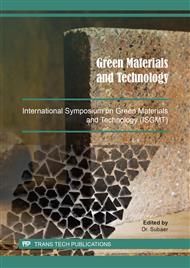[1]
Ghosh, Sougata., Sumersing Patil, Mehul Ahire, Rohini Kitture, Sangeeta Kale, Karishma Pardesi, Swaranjit S Cameotra, Jayesh Bellare, Dilip D Dhavale, Amit Jabgunde dan Balu A Chopade. 2012. Synthesis of silver nanoparticles using Dioscorea bulbifera tuber extract and evaluation of its synergistic potential in combination with antimicrobial agents. International Journal of Nanomedicine. Vol. 7, Hal. 483-496.
DOI: 10.2147/ijn.s24793
Google Scholar
[2]
Horiba. 2014. PSA Guidebook. USA: Horiba Instruments, Inc.
Google Scholar
[3]
Korbekandi, Hassan dan Siavash Iravani. 2012. Silver Nanoparticles. The Delivery of Nanoparticles. ISBN: 978-953-51-0615-9.
Google Scholar
[4]
Krithiga, Narayanaswamy., Athimoolam Rajalakshmi dan Ayyavoo Jayachitra. 2015. Green Synthesis of Silver Nanoparticles Using Leaf Extracts of Clitoria ternatea and Solanum nigrum and Study of Its Antibacterial Effect against Common Nosocomial Pathogens. Journal of Nanoscience. Volume 2015, Article ID 928204, 8 pages.
DOI: 10.1155/2015/928204
Google Scholar
[5]
Laroui, Hamed., David S. Wilson, Guillaume Dalmasso, Khalid Salaita, Niren Murthy, Shanthi V. Sitaraman dan Didier Merlin. 2010. Nanomedicine in GI. Am J Physiol Gastrointest Liver Physiol. Vol 300. Hal. 371-383.
DOI: 10.1152/ajpgi.00466.2010
Google Scholar
[6]
Loo, Yuet Ying., Buong Woei Chieng, Mitsuaki Nishibuchi dan Son Radu. 2012. Synthesis of silver nanoparticles by using tea leaf extract from Camellia Sinensis. International Journal of Nanomedicine. Vol 7. Hal. 4263–4267.
DOI: 10.2147/ijn.s33344
Google Scholar
[7]
Mallikarjuna, K., G. Narasimha, G. R. Dillip, B. Praveen, B. Shreedhar, C. Sree Lakshmi, B. V. S. Reddy dan B. Deva Prasad Raju. 2011. Green Synthesis of Silver Nanoparticles Using Ocimum Leaf Extract and Their Characterization. Digest Journal of Nanomaterials and Biostructures. Vol. 6, No. 1.
Google Scholar
[8]
Malvern. 2011. Dynamic Light Scattering Common Terms Defined. Worcestershire: Malvern Instruments Ltd.
Google Scholar
[9]
Mohapatra, Bandita., Reena Kaintura, Jaspal Singh, Sini Kuriakose dan Satyabrata Mohapatra. 2015. Biosynthesis of high concentration, stable aqueous dispersions of silver nanoparticles using Citrus limon extract. Advanced Materials Letters. Vol. 6, No. 3.
DOI: 10.5185/amlett.2015.5731
Google Scholar
[10]
Naik, L. Srinivas., K. Paul Marx, P. Sree Vennela dan Venkata Ramana Devi. 2013.Green synthesis of silver nanoparticles using Strawberry leaf extract (Arbutus unedo) and evaluation of its antimicrobial activity-a Novel study. International Journal of Nanomaterials and Biostructures; Vol. 3, No. 3, Hal: 47-50.
Google Scholar
[11]
Nanocomposix.com. 2014. Silver Nanoparticles: Physical Properties. (online): nanocomposix.com/kb/silver/physical-properties. Diakses tanggal 1 Mei (2017).
Google Scholar
[12]
Omogbai, Barry Aigbodion, Ikenebomeh dan Marcel. 2013. Microbiological Characteristics and Phytochemical Screening of Some Herbal Teas in Nigeria. European Scientific Journal. Vol. 9, No. 18.
Google Scholar
[13]
Pacioni, Natalia L., Claudio D. Borsarelli, Valentina Rey dan Alicia V. Veglia. 2015. Synthetic Routes for the Preparation of Silver Nanoparticles. Springer International. DOI 10.1007/978-3-319-11262-6_2.
DOI: 10.1007/978-3-319-11262-6_2
Google Scholar
[14]
Ponarulselvam, S., Panneerselvam C, Murugan K, Aarthi N, Kalimuthu K dan Thangamani S. 2012. Synthesis of silver nanoparticles using leaves of Catharanthus roseus Linn. G. Don and their antiplasmodial activities. Asian Pacific Journal of Tropical Biomedicine. Vol. 2, No. 7.
DOI: 10.1016/s2221-1691(12)60100-2
Google Scholar
[15]
Rahmanisa, Soraya dan Rika Oktaria. 2016. Pengaruh Epigallocatechin-3-Gallate (EGCG) pada Teh Hijau Terhadap Acne vulgaris. Majority. Vol. 5, No. 2.
Google Scholar
[16]
Shah, Monaliben., Derek Fawcett, Shashi Sharma, Suraj Kumar Tripathy dan Gérrard Eddy Jai Poinern. 2015. Green Synthesis of Metallic Nanoparticles via Biological Entities. Materials. Vol. 8, Hal. 7278-7308.
DOI: 10.3390/ma8115377
Google Scholar
[17]
Sondari, Dewi., Agus Haryono dan S. Tursiloadi. 2009. Sintesa Nanopartikel Besi Oksida dengan Menggunakan Asam Oleat Sebagai Capping Reagent. Kimia Anorganik, Analitik, Fisika, dan Lingungan. ISBN : 979-498-467-1.
Google Scholar
[18]
Woodford, Chris. 2007. Electron microscopes. (online): www.explainthatstuff.com/electronmicroscopes.html. Diakses tanggal 01Mei (2017).
Google Scholar
[19]
Yasin, Sohail., Lin Liu dan Juming Yao. 2013. Biosynthesis of Silver Nanoparticles by Bamboo Leaves Extract and Their Antimicrobial Activity. Journal of Fiber Bioengineering and Informatics. Vol. 6, No. 1.
DOI: 10.3993/jfbi03201307
Google Scholar


